ADAImpact Tool: Toward a European Ground Motion Impact Map
Abstract
1. Introduction
2. Materials and Methods
2.1. The Concept of Potential Impact
2.2. The ADAImpact Tool
2.2.1. ADAImpact Workflow
- (a)
- Classification of Process Magnitude
- (b)
- Classification of Exposure
- (c)
- Classification of Potential Impact
2.2.2. The GUI
2.3. Input Data
2.3.1. Process Magnitude
2.3.2. Exposed Buildings
2.3.3. Exposed Population
2.3.4. Exposed Critical Infrastructures and Equipment
2.4. Output Data
3. Results
3.1. Border Between Portugal and Spain
3.2. Coastal Zone of Granada (Spain)
3.3. Validation
4. Discussion
5. Conclusions
- The development of the ADAImpact tool enables ordinary users to geographically identify geohazards and ground motion that can have a potential impact on exposed structures, infrastructures and people.
- The tool can be used across any location in Europe in a simple and intuitive way, utilizing data provided by the EGMS.
- The ADAImpact is able to evaluate the process magnitude by comprehensively considering all the information included in the ADA map, such as the process type, the velocity, the spatial extent and the temporal evolution of the movement.
- The exposure assessment methodology is both universal and flexible, allowing the use of open data and considering any critical infrastructure or equipment existing in the study area.
- Categorizing potential impact with the ADAImpact tool enables civil protection decision makers to establish priorities and define actions to safeguard people and property, following specific guidelines for each impact class.
- The cartographic results related to process magnitude, exposure (population and buildings), and potential impact constitute valuable products for programs such as the Copernicus Emergency Management Service.
Author Contributions
Funding
Data Availability Statement
Conflicts of Interest
References
- Salichon, J.; Le Cozannet, G.; Modaressi, H.; Hosford, S.; Missotten, R.; McManus, K.; Marsh, S.; Paganini, M.; Ishida, C.; Plag, H.P.; et al. 2nd IGOS Geohazards Theme Report; BRGM: Orléans, France, 2007; pp. 1–87.
- EMDAT. The Emergency Events Database; UCL–CRED: Brussels, Belgium, 2019; Available online: www.emdat.be (accessed on 10 August 2025).
- Asteris, P.G.; Cavaleri, L.; di Trapani, F.; Macaluso, G.; Scaduto, G. Definition of Seismic Vulnerability Maps for Civil Protection Systems: The Case of Lampedusa Island. Open Constr. Build. Technol. J. 2016, 10, 87–105. [Google Scholar] [CrossRef]
- Solari, L.; Barra, A.; Herrera, G.; Bianchini, S.; Monserrat, O.; Béjar-Pizarro, M.; Crosetto, M.; Sarro, R.; Moretti, S. Fast detection of ground motions on vulnerable elements using Sentinel-1 InSAR data. Geomat. Nat. Hazards Risk 2018, 9, 152–174. [Google Scholar] [CrossRef]
- Wania, A.; Joubert-Boitat, I.; Dottori, F.; Kalas, M.; Salamon, P. Increasing timeliness of satellite-based flood mapping using early warning systems. Remote Sens. 2021, 13, 2114. [Google Scholar] [CrossRef]
- Barra, A.; Cuevas-González, M.; Navarro, J.; Béjar-Pizarro, M.; Ezquerro, P.; Bianchini, S.; Zezere, J.L.; Medici, C.; Del Soldato, M.; Palamà, R.; et al. ADATools: Free and User-Friendly Tools to Semiautomatically Extract and Analyse Wide PSI Displacement Maps; EGU General Assembly: Vienna, Austria, 2024; EGU24-20708. [Google Scholar] [CrossRef]
- Costantini, M.; Minati, F.; Trillo, F.; Ferretti, A.; Novali, F.; Passera, E.; Dehls, J.; Larsen, Y.; Marinkovic, P.; Eineder, M.; et al. European ground motion service (EGMS). In Proceedings of the 2021 IEEE International Geoscience and Remote Sensing Symposium IGARSS, Brussels, Belgium, 11–16 July 2021; pp. 3293–3296. [Google Scholar]
- Mirmazloumi, S.M.; Wassie, Y.; Navarro, J.A.; Palamà, R.; Krishnakumar, V.; Barra, A.; Cuevas-González, M.; Crosetto, M.; Monserrat, O. Classification of ground deformation using Sentinel-1 persistent scatterer interferometry time series. GISci. Remote Sens. 2022, 59, 374–392. [Google Scholar] [CrossRef]
- Navarro, J.A.; Cuevas, M.; Tomás, R.; Barra, A.; Crosetto, M. A toolset to detect and classify active deformation areas using Interferometric SAR Data. In Proceedings of the 5th International Conference on Geographical Information Systems Theory, Applications and Management—GISTAM, Crete, Greece, 3–5 May 2019; pp. 167–174. [Google Scholar] [CrossRef]
- Tarpanelli, A.; Mondini, A.C.; Camici, S. Effectiveness of Sentinel-1 and Sentinel-2 for flood detection assessment in Europe. Nat. Hazards Earth Syst. Sci. 2022, 22, 2473–2489. [Google Scholar] [CrossRef]
- Capes, R.; Passera, E. Product Description and Format Specification. EGMS v2.0. Copernicus Land Tech Libr. 2023. Available online: https://land.copernicus.eu/.../egms-product-description-document/ (accessed on 15 January 2024).
- Donezar-Hoyos, U.; Albizua-Huarte, L.; Amezketa-Lizarraga, E.; Barinagarrementeria-Arrese, I.; Ciriza, R.; De Blas-Corral, T.; Larrañaga-Urien, A.; Ros-Elso, F.; Tamés-Noriega, A.; Viñuales-Lasheras, M.; et al. The Copernicus EMS validation service as a vector for improving the emergency mapping based on Sentinel data. Rev. Teledetec. 2020, 56, 23–34. [Google Scholar] [CrossRef]
- Mastrantoni, G.; Masciulli, C.; Marini, R.; Esposito, C.; Mugnozza, G.S.; Mazzanti, P. A novel model for multi-risk ranking of buildings at city level based on open data: The test site of Rome, Italy. Geomat. Nat. Hazards Risk 2023, 14, 2275541. [Google Scholar] [CrossRef]
- López-Vinielles, J.; Ezquerro, P.; Béjar-Pizarro, M.; Sarro, R.; Cuevas-González, M.; Barra, A.; Mateos, R.M. Potential socio-economic impacts of ground movements in the coastal municipalities of Spain: Insights from the supra-regional implementation of the European Ground Motion Service. Ocean Coast. Manag. 2024, 259, 107452. [Google Scholar] [CrossRef]
- QGIS. QGIS Download. 2024. Available online: https://www.qgis.org/download/ (accessed on 15 January 2024).
- InaSAFE. InaSAFE: Free Software for Natural Hazard Impact Modelling. 2023. Available online: https://inasafe.org (accessed on 10 September 2025).
- GEM Foundation; CEDIM. Integrated Risk Modelling Toolkit (IRMT), User Manual (Release 3.16.1). QGIS Plugin. 2023. Available online: https://docs.openquake.org/oq-irmt-qgis/v3.16.1/ (accessed on 10 September 2025).
- Barra, A.; Solari, L.; Béjar-Pizarro, M.; Monserrat, O.; Bianchini, S.; Herrera, G.; Moretti, S. A methodology to detect and update active deformation areas based on Sentinel-1 SAR images. Remote Sens. 2017, 9, 1002. [Google Scholar] [CrossRef]
- Monserrat, O.; Barra, A.; Béjar-Pizarro, M.; Rivera, J.S.; Galve, J.P.; Guardiola, C.; Cuevas-González, M.; Mateos, R.M.; Ezquerro, P.; Azañon, J.M.; et al. ADATools: Free and easy-to-use tools for semi-automatically extracting and analysing multitemporal interferometric displacement maps. Int. Arch. Photogramm. Remote Sens. Spat. Inf. Sci. 2024, 48, 351–356. [Google Scholar] [CrossRef]
- UNDRR. Global Assessment Report on Disaster Risk Reduction (GAR2019); United Nations Office for Disaster Risk Reduction: Geneva, Switzerland, 2019. [Google Scholar]
- IPCC. Climate Change 2014: Impacts, Adaptation, and Vulnerability. Part A: Global and Sectoral Aspects; Cambridge University Press: Cambridge, UK; New York, NY, USA, 2014; 1132p. [Google Scholar]
- Varnes, D.J. Landslide Hazard Zonation: A Review of Principles and Practice; UNESCO: Paris, France, 1984. [Google Scholar]
- Guzzetti, F.; Carrara, A.; Cardinali, M.; Reichenbach, P. Landslide hazard evaluation: A review of current techniques and their application in a multiscale study, Central Italy. Geomorphology 1999, 31, 181–216. [Google Scholar] [CrossRef]
- Maiti, S.; Jha, S.K.; Garai, S.; Nag, A.; Bera, A.; Paul, V.; Upadhaya, R.; Deb, S. An assessment of social vulnerability to climate change among the districts of Arunachal Pradesh, India. Ecol. Indic. 2017, 77, 105–113. [Google Scholar] [CrossRef]
- Contreras, D.; Chamorro, A.; Wilkinson, S. The spatial dimension in the assessment of urban socio-economic vulnerability related to geohazards. Nat. Hazards Earth Syst. Sci. 2020, 20, 1663–1687. [Google Scholar] [CrossRef]
- Santos, P.P.; Zêzere, J.L.; Pereira, S.; Rocha, J.; Tavares, A.O. A novel approach to measuring spatiotemporal changes in social vulnerability at the Local Level in Portugal. Int. J. Disaster Risk Sci. 2022, 13, 842–861. [Google Scholar] [CrossRef]
- United Nations. Report of the Open-Ended Intergovernmental Expert Working Group on Indicators and Terminology Relating to Disaster Risk Reduction; A/71/644; United Nations Office for Disaster Risk Reduction: Geneva, Switzerland, 2016. [Google Scholar]
- Alexander, D. Models of Social Vulnerability to Disasters. RCCS Annu. Rev. 2012, 4, 22–40. [Google Scholar] [CrossRef]
- Marulanda Fraume, M.C.; Cardona, A.O.D.; Fraume, P.M.; T, M.-L.C.; Barbat, A.H. Evaluating risk from a holistic perspective to improve resilience: The United Nations evaluation at global level. Saf. Sci. 2020, 127, 104739. [Google Scholar] [CrossRef]
- Guzzetti, F.; Ardizzone, F.; Cardinali, M.; Rossi, M.; Valigi, D. Landslide Volumes and Landslide Mobilization Rates in Umbria, Central Italy. Earth Planet. Sci. Lett. 2009, 279, 222–229. [Google Scholar] [CrossRef]
- Gutiérrez, F.; Parise, M.; De Waele, J.; Jourde, H. A review on natural and human-induced geohazards and impacts in karst. Earth-Sci. Rev. 2014, 138, 61–88. [Google Scholar] [CrossRef]
- Froude, M.J.; Petley, D.N. Global fatal landslide occurrence from 2004 to 2016. Nat. Hazards Earth Syst. Sci. 2018, 18, 2161–2181. [Google Scholar] [CrossRef]
- Schiavina, M.; Freire, S.; Carioli, A.; MacManus, K. GHS-POP R2023A—GHS Population Grid Multitemporal (1975–2030); JRC, European Commission: Brussels, Belgium, 2023. [Google Scholar]
- Melchiorri, M.; Pesaresi, M.; Florczyk, A.J.; Corbane, C.; Kemper, T. Principles and applications of the global human settlement layer as Baseline for the Land Use Efficiency Indicator—SDG 11.3.1. ISPRS Int. J. Geo-Inf. 2019, 8, 96. [Google Scholar] [CrossRef]
- Pesaresi, M.; Huadong, G.; Blaes, X.; Ehrlich, D.; Ferri, S.; Gueguen, L.; Halkia, M.; Kauffmann, M.; Kemper, T.; Lu, L.; et al. A global human settlement layer from optical HR/VHR RS data: Concept and First Results. IEEE J. Sel. Top. Appl. Earth Obs. Remote Sens. 2013, 6, 2102–2131. [Google Scholar] [CrossRef]
- Freire, S.; MacManus, K.; Pesaresi, M.; Doxsey-Whitfield, E.; Mills, B. Development of new open and free multi-temporal global population spatial raster datasets at 250 m resolution. In Proceedings of the Geospatial Data in a Changing World, AGILE, Helsinki, Finland, 14–17 June 2016. JRC100523. [Google Scholar]
- Geofabrik. Geofabrik Download Server. 2018. Available online: https://download.geofabrik.de/ (accessed on 15 July 2023).
- Barra, A.; Reyes-Carmona, C.; Herrera, G.; Galve, J.P.; Solari, L.; Mateos, R.M.; Azañón, J.M.; Béjar-Pizarro, M.; López-Vinielles, J.; Palamà, R.; et al. From Satellite Interferometry Displacements to Potential Damage Maps: A Tool for Risk Reduction and Urban Planning. Remote Sens. Environ. 2022, 282, 113294. [Google Scholar] [CrossRef]
- Bru, G.; Ezquerro Martín, P.; López-Vinielles, J.; Reyes-Carmona, C.; Guardiola-Albert, C.; Béjar Pizarro, M. Manual Básico sobre el Uso de Datos InSAR para Medir Desplazamientos de la Superficie del Terreno; CSIC—Instituto Geológico y Minero de España (IGME): Madrid, Spain, 2024; Available online: https://digital.csic.es/handle/10261/360969 (accessed on 10 September 2025).
- Talledo, D.A.; Miano, A.; Bonano, M.; Di Carlo, F.; Lanari, R.; Manunta, M.; Meda, A.; Mele, A.; Prota, A.; Saetta, A.; et al. Satellite Radar Interferometry: Potential and Limitations for Structural Assessment and Monitoring. J. Build. Eng. 2022, 46, 103756. [Google Scholar] [CrossRef]
- Cruden, D.M.; Varnes, D.J. Landslide Types and Processes. In Landslides: Investigation and Mitigation, Special Report 247; Turner, A.K., Schuster, R.L., Eds.; Transportation Research Board, National Research Council, National Academy Press: Washington, DC, USA, 1996; pp. 36–75. [Google Scholar]
- Bianchini, S.; Solari, L.; Bertolo, D.; Thuegaz, P.; Catani, F. Integration of Satellite Interferometric Data in Civil Protection Strategies for Landslide Studies at a Regional Scale. Remote Sens. 2021, 13, 1881. [Google Scholar] [CrossRef]
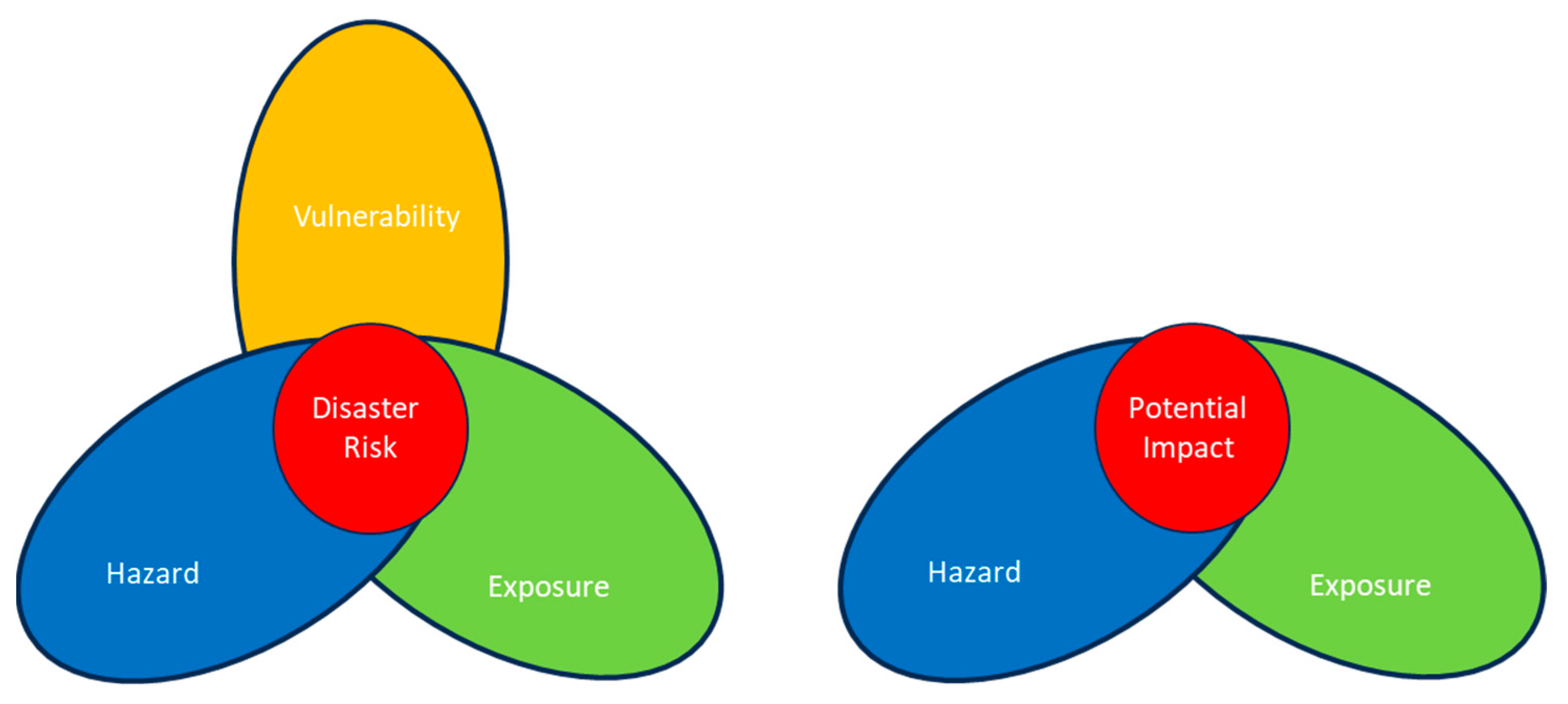
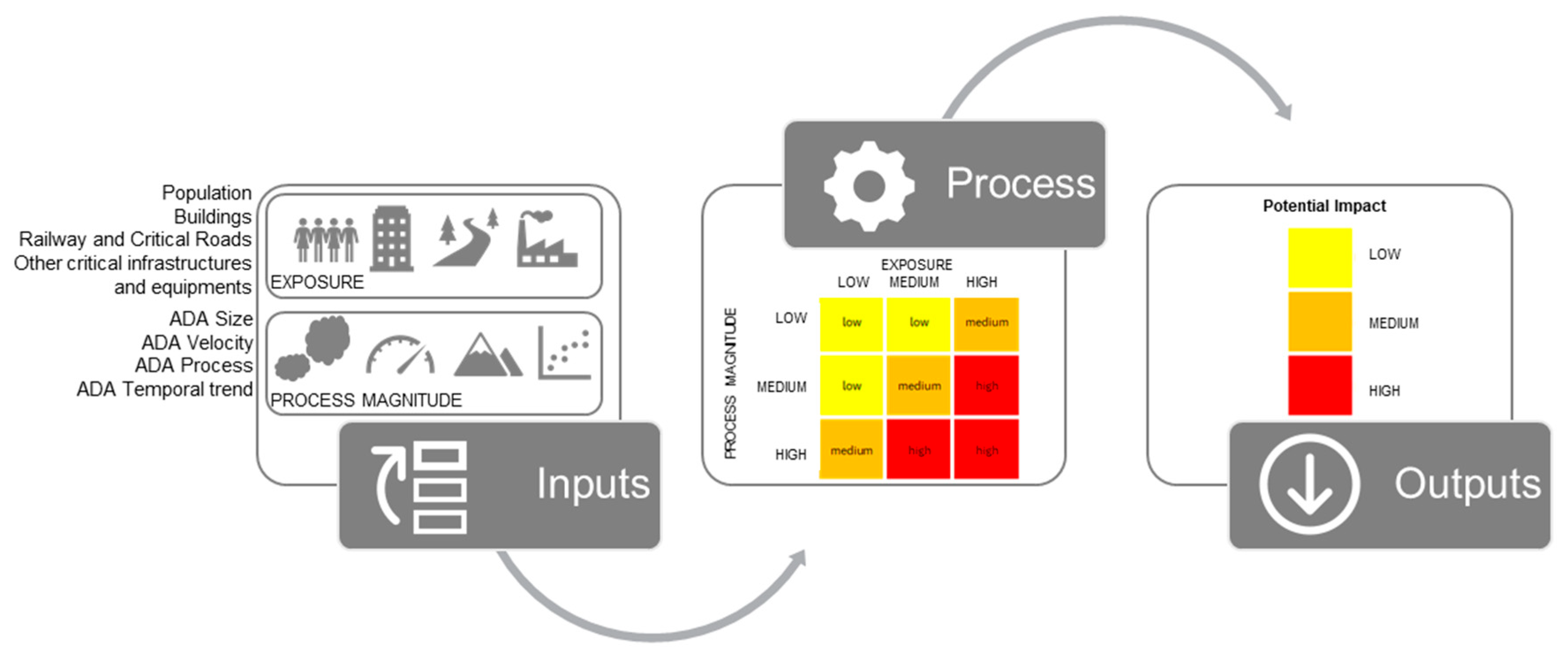
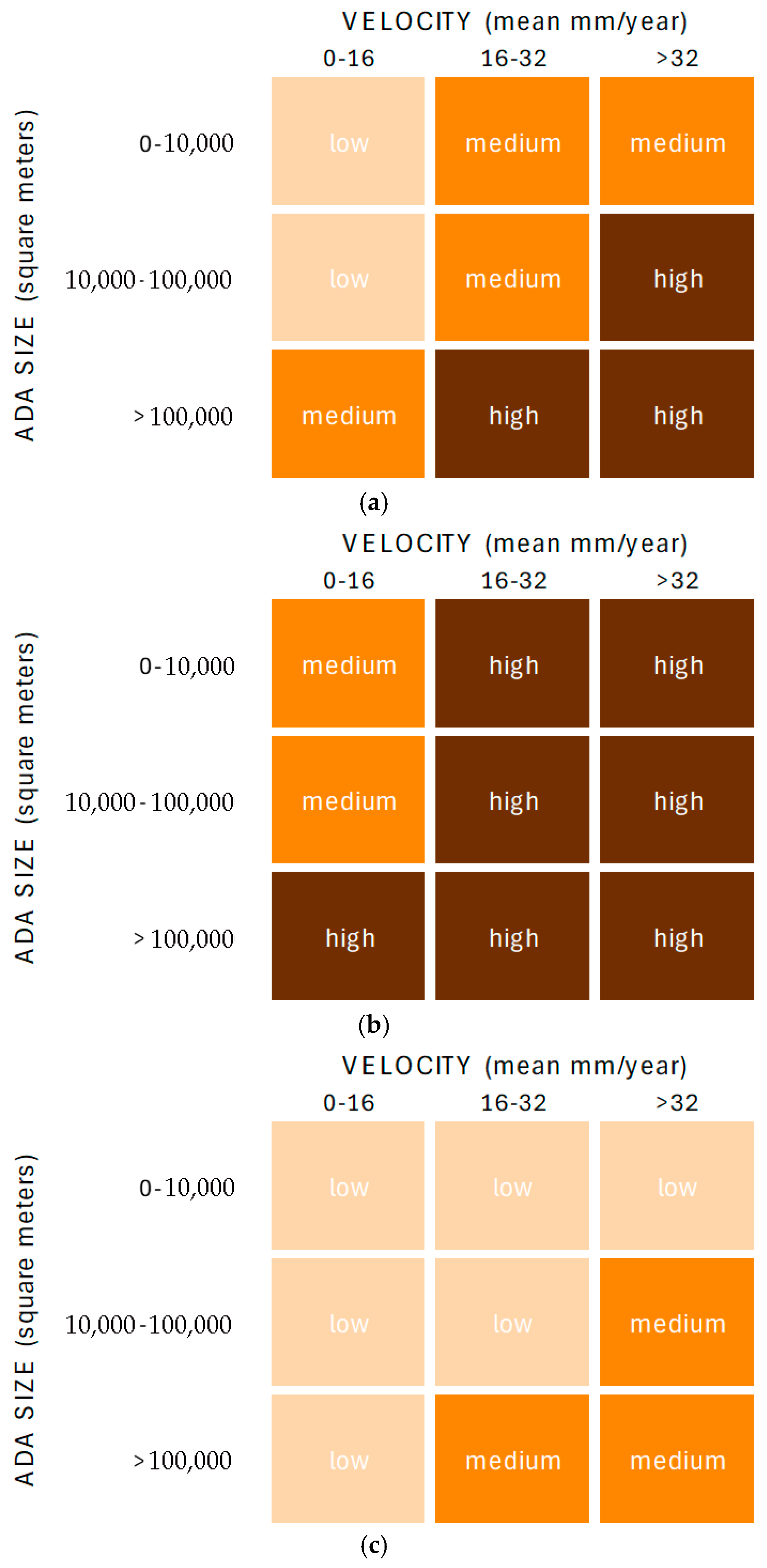
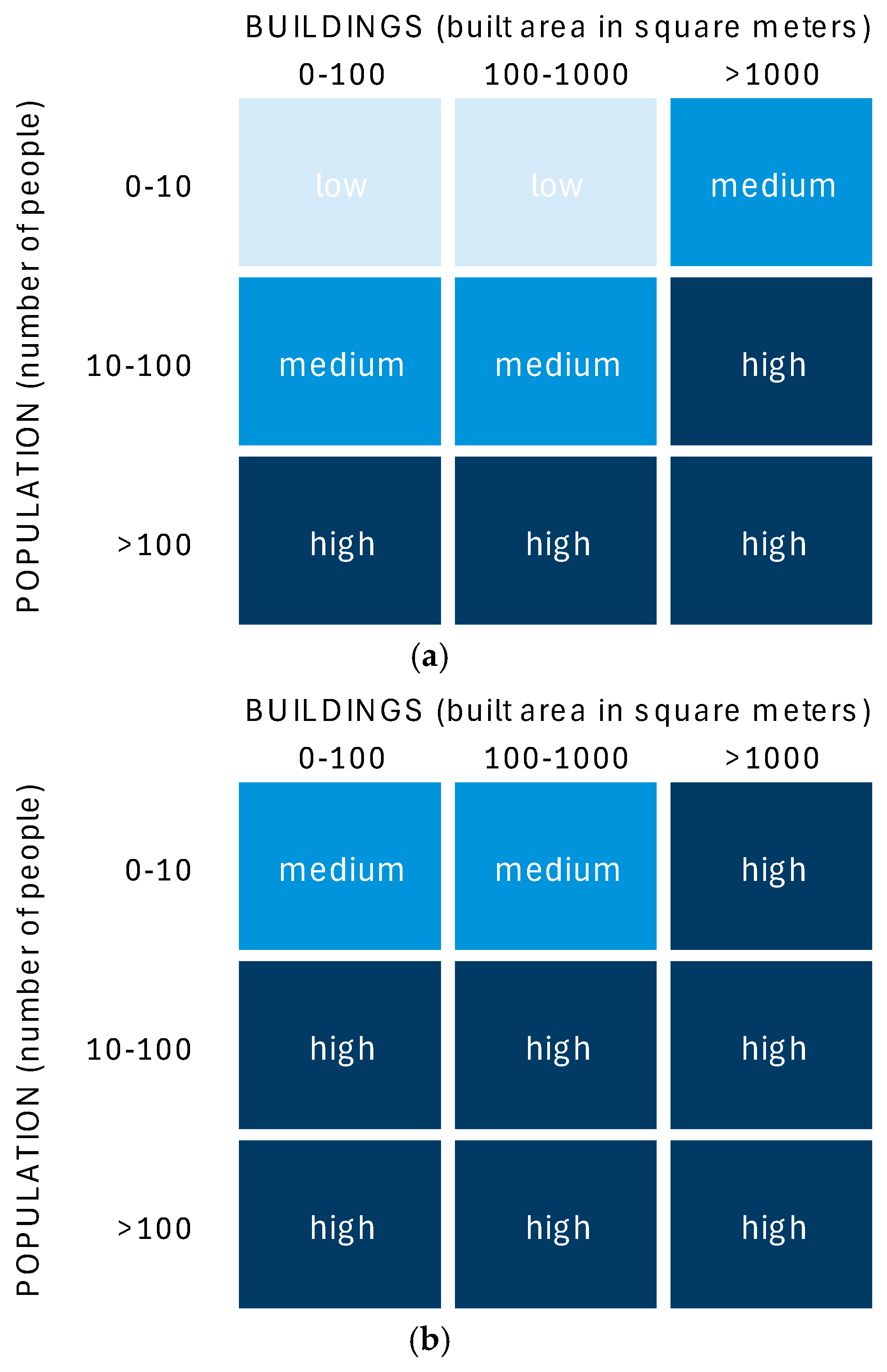
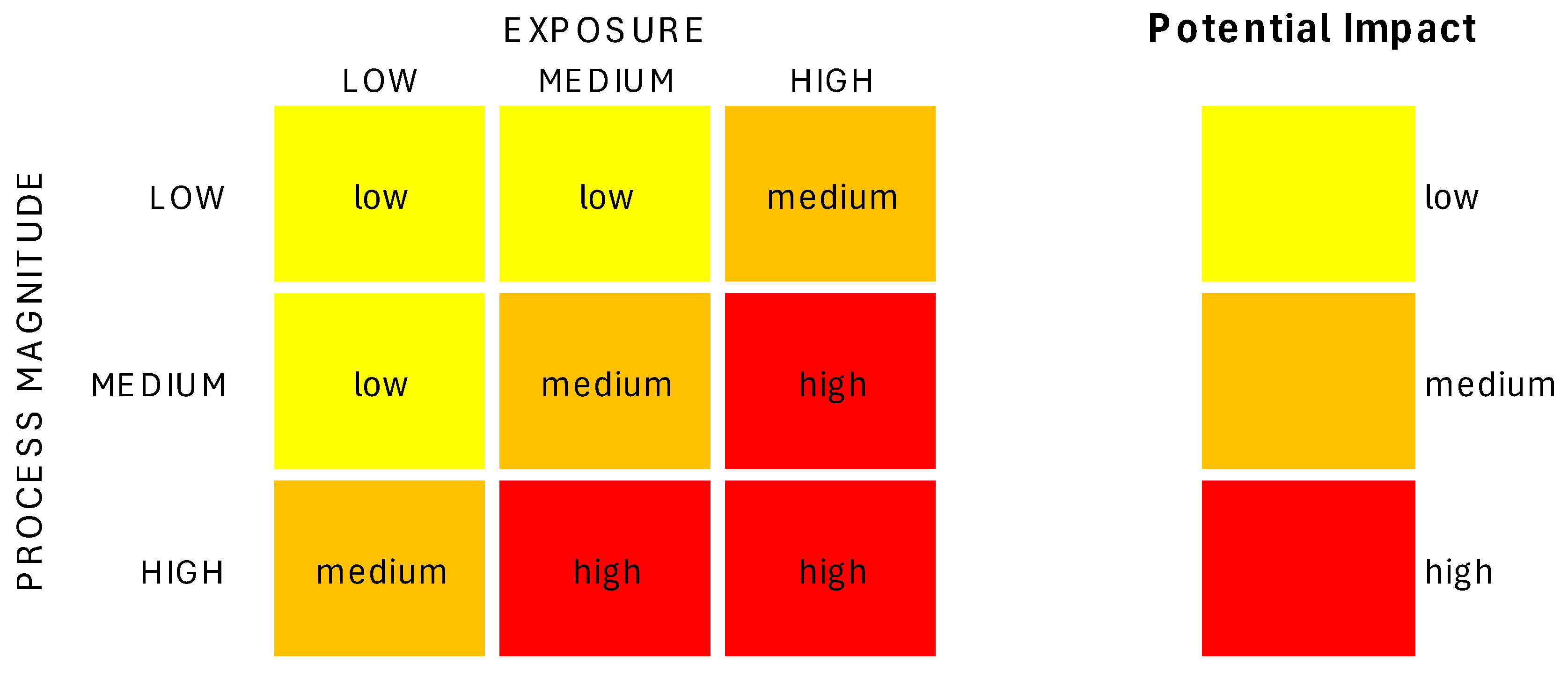
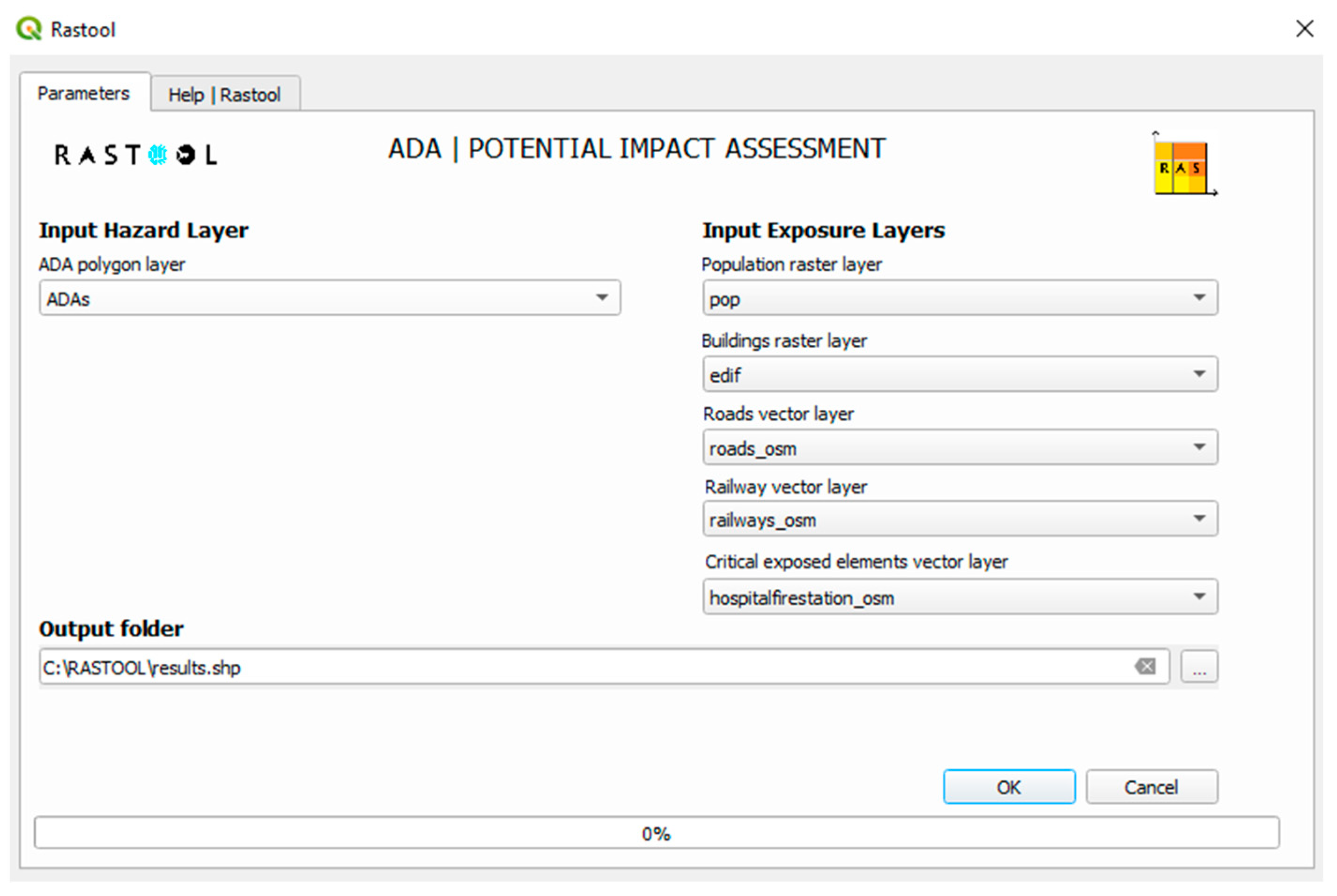
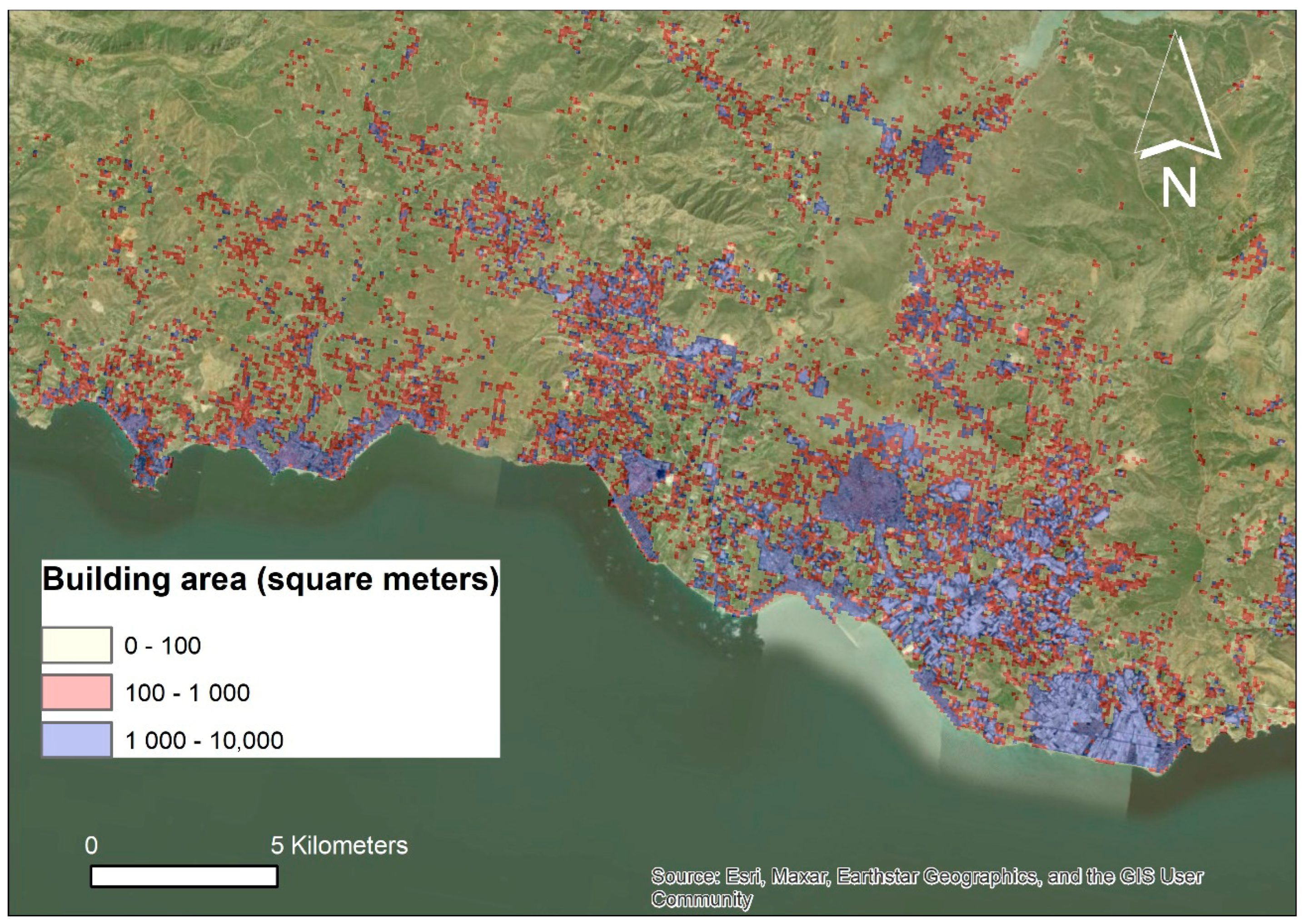
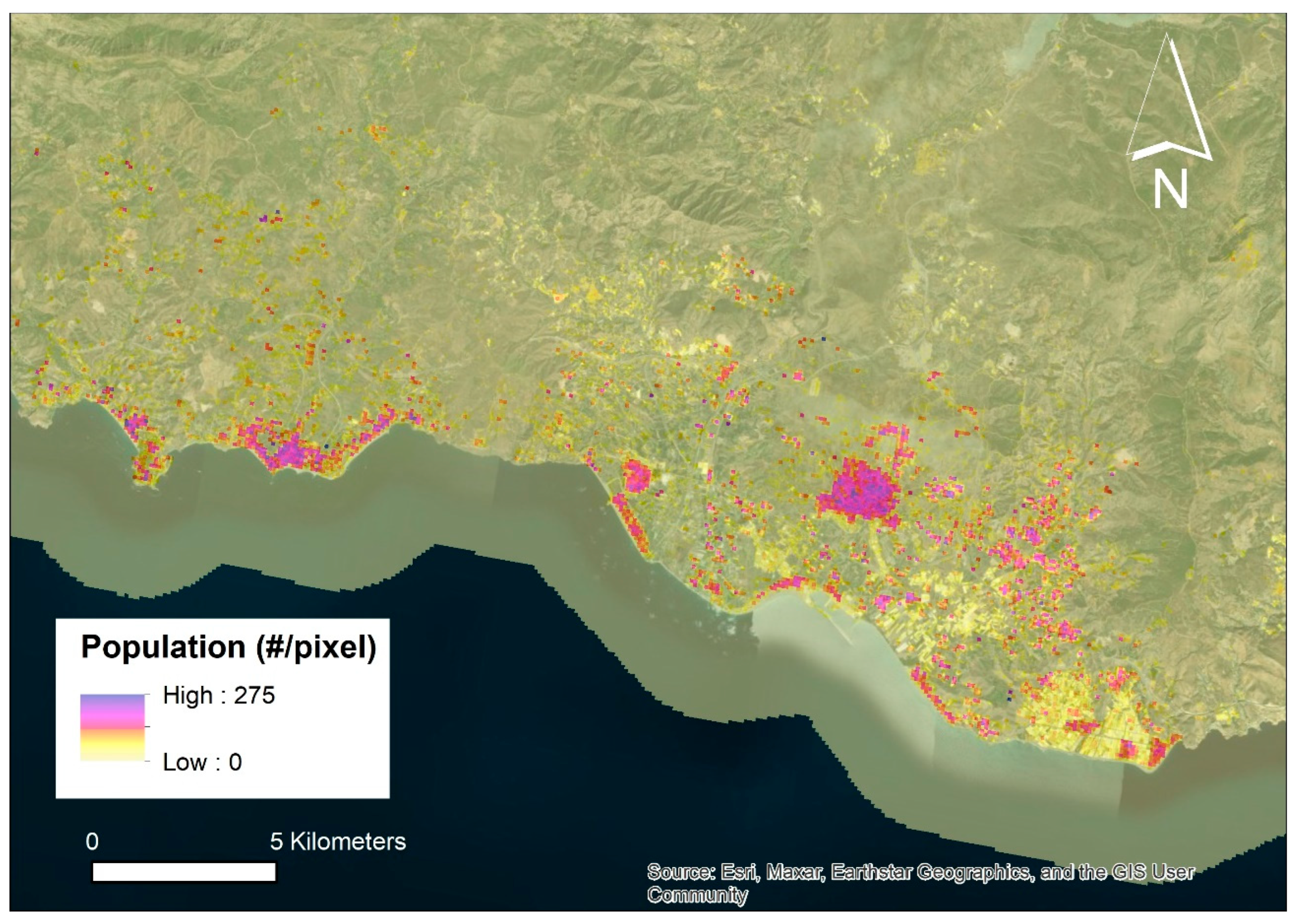
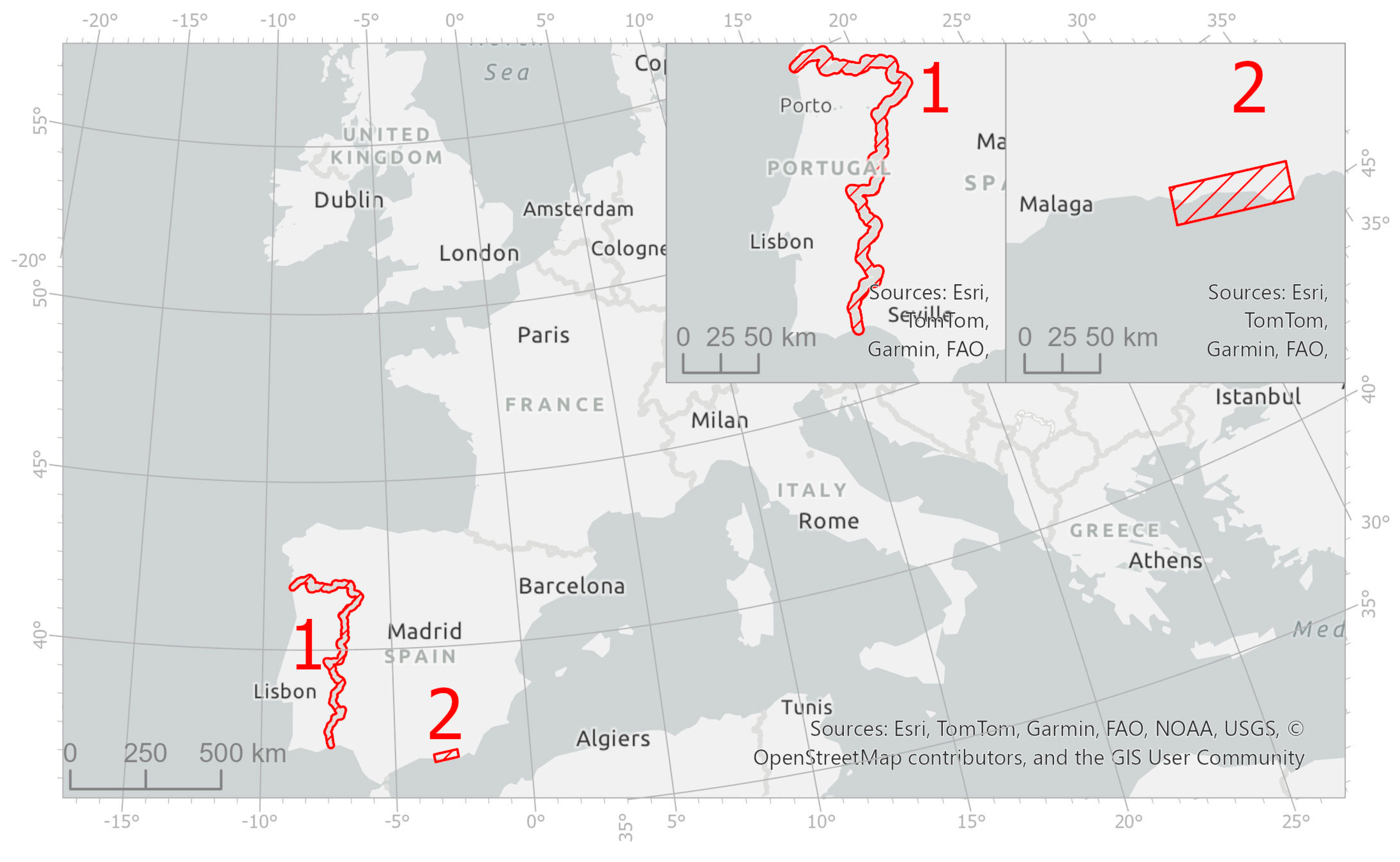
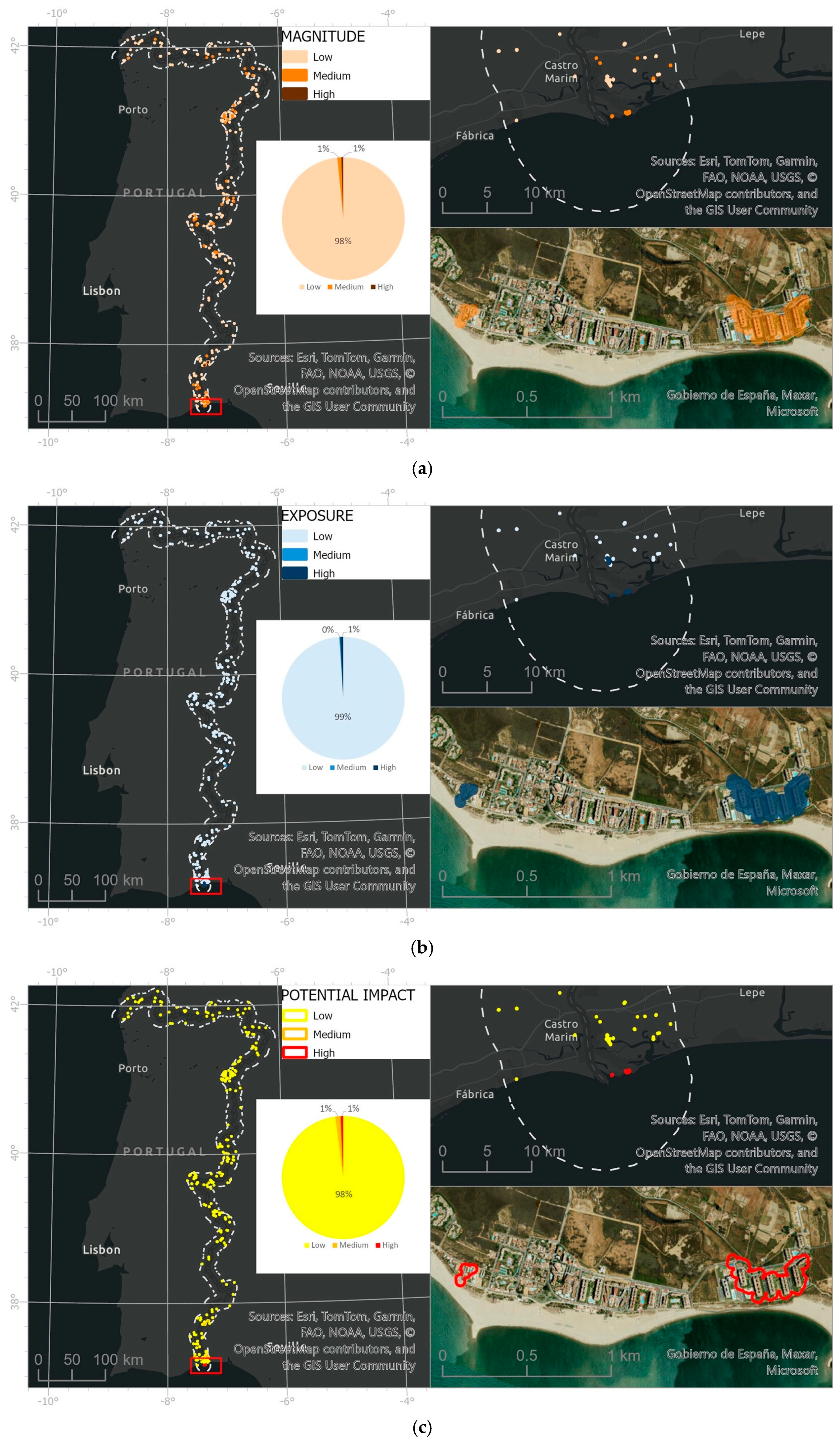
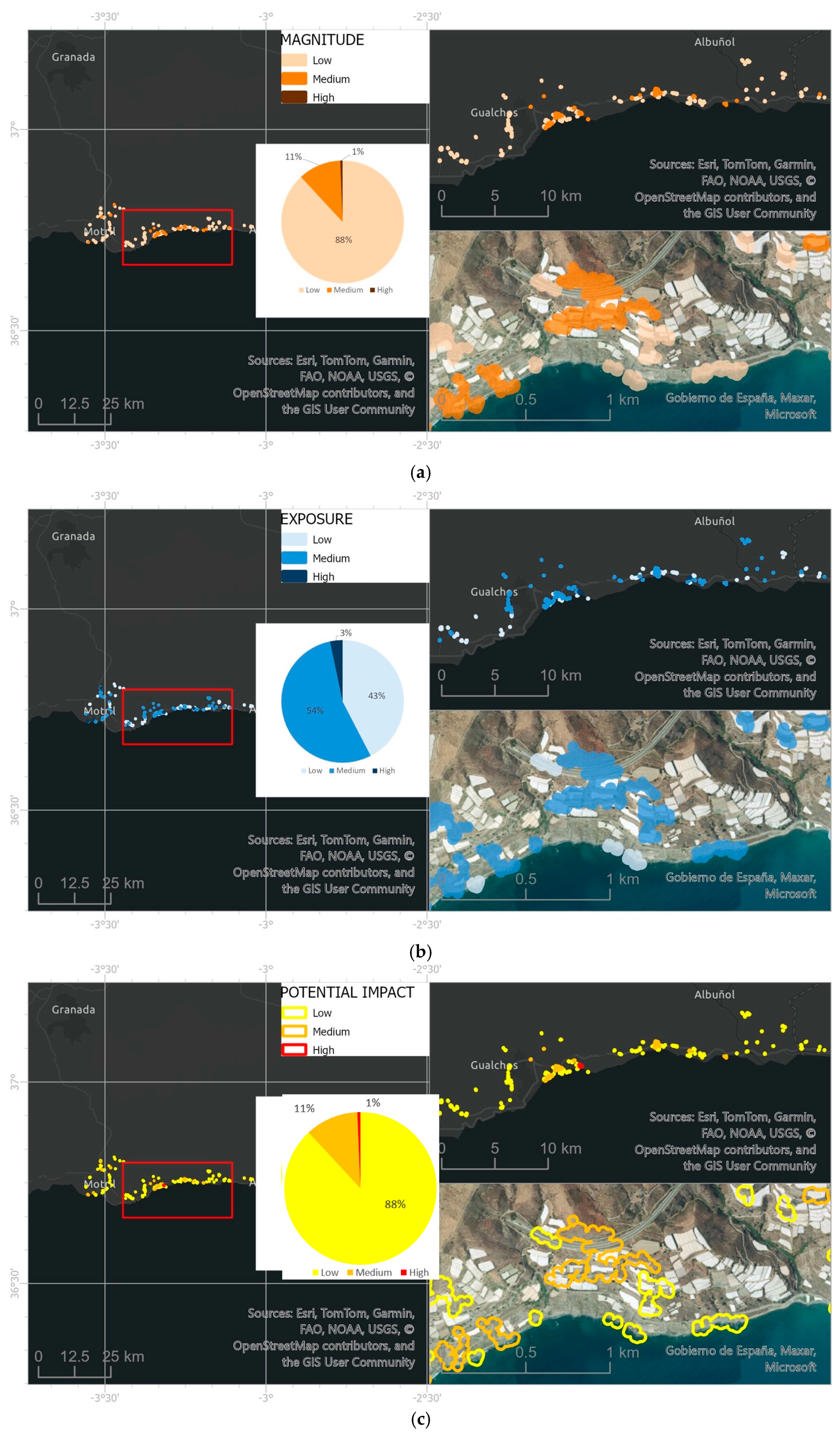
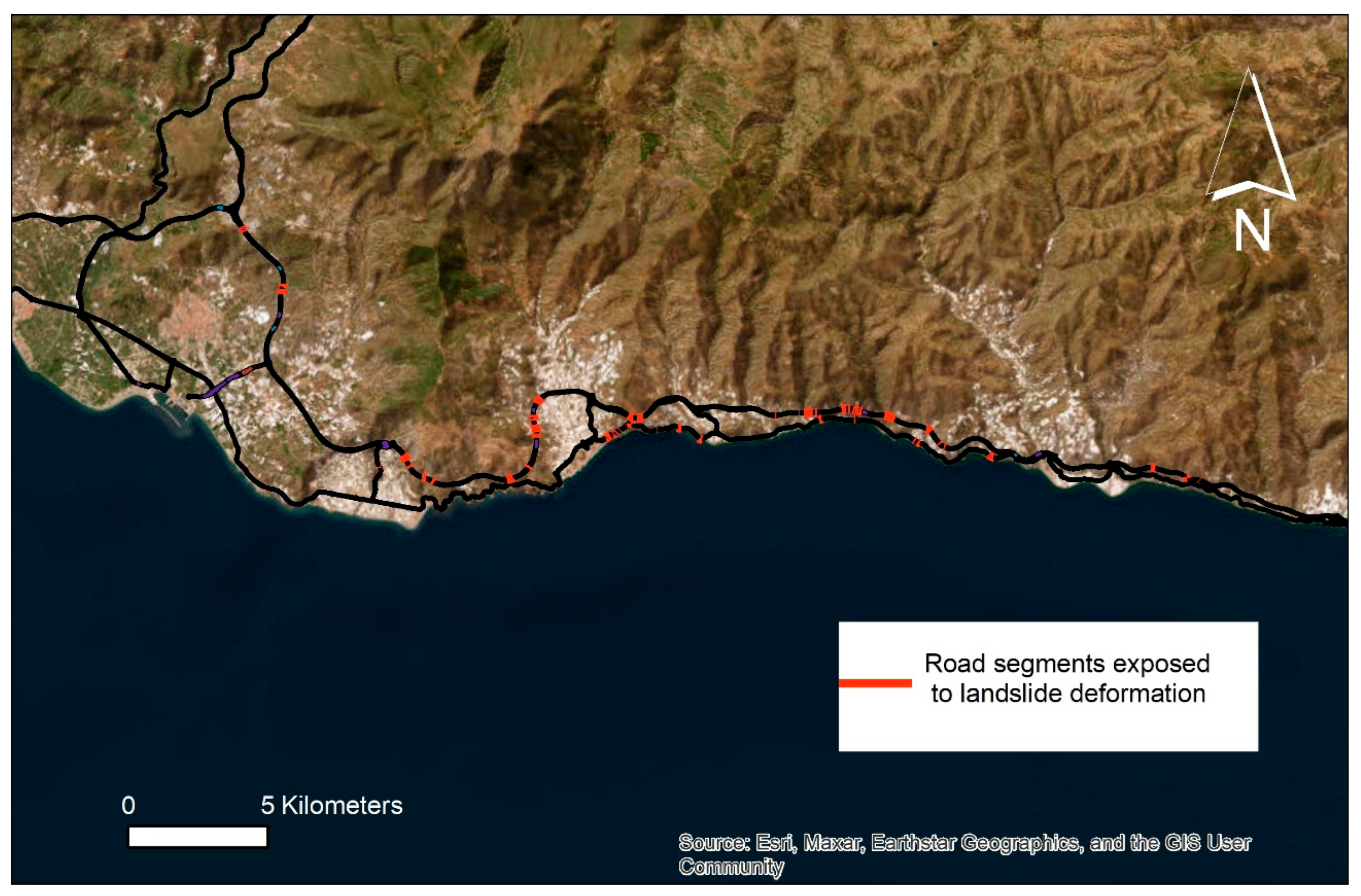
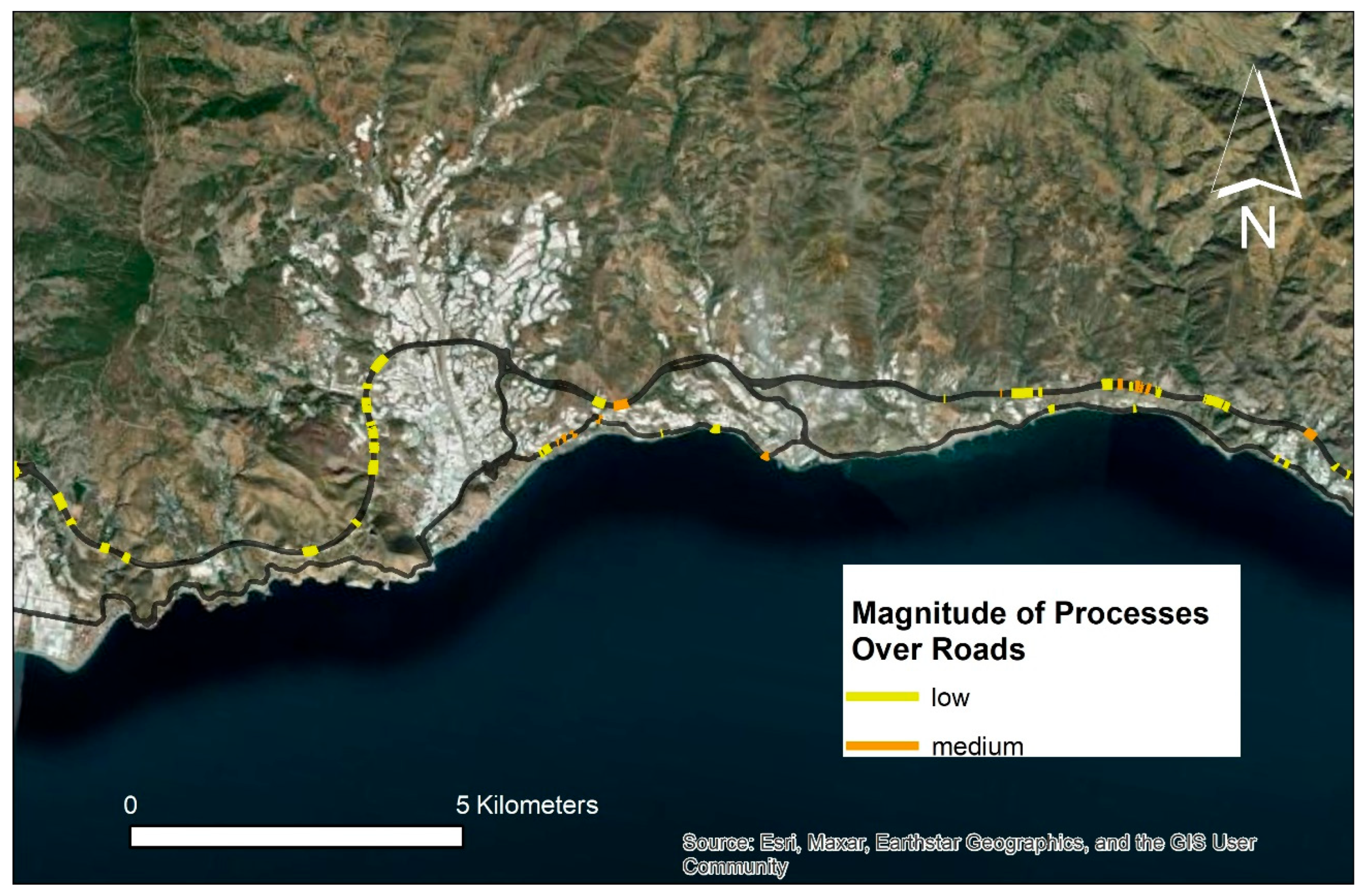
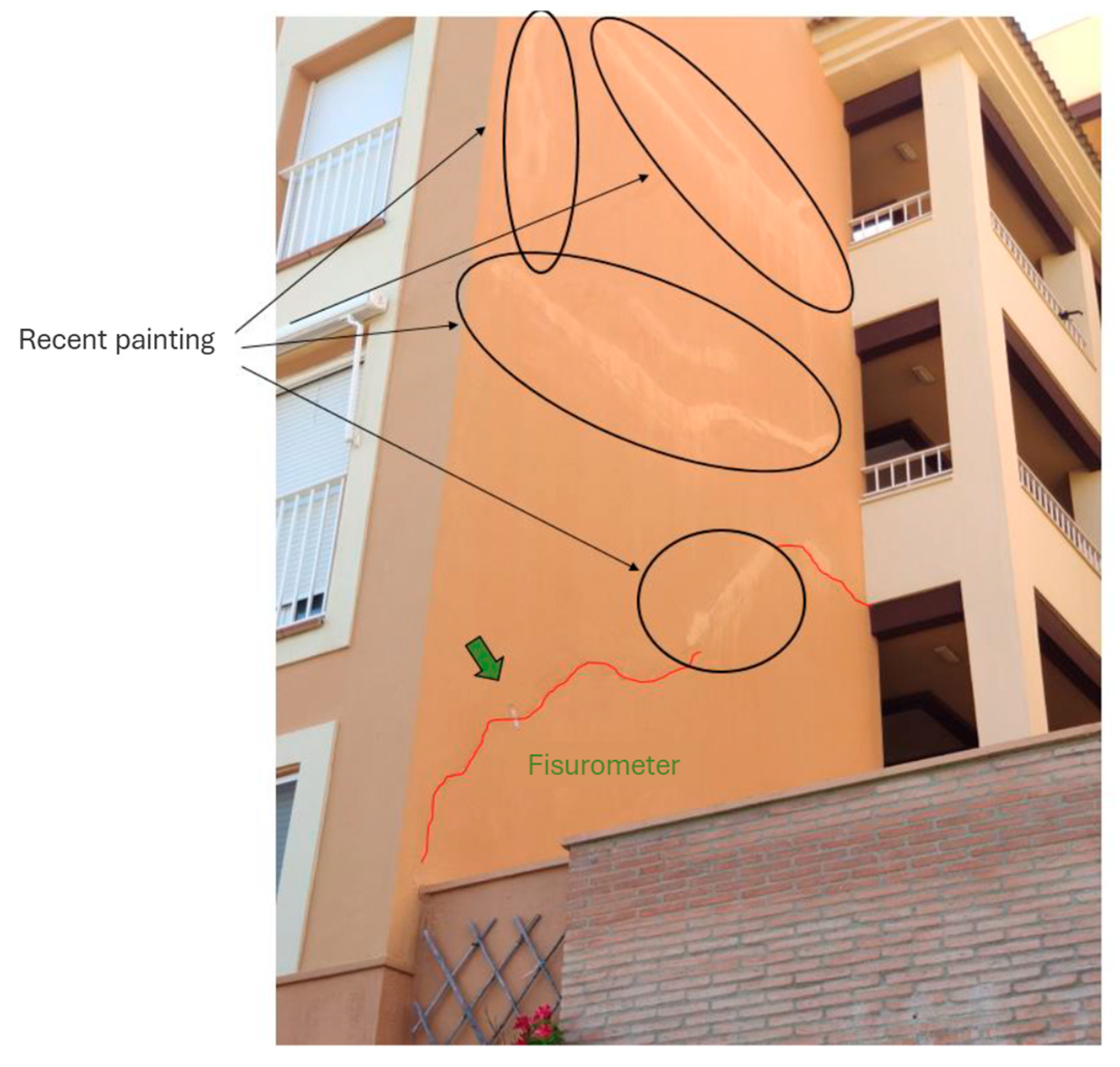
| Description | Layer | Extracted classes | Source |
|---|---|---|---|
| Railways | gis_osm_railways_free_1 | All classes | OSM |
| Roads | gis_osm_roads_free_1 | Motorway, Motorway link, Primary, Trunk, Trunk link | OSM |
| Infrastructure and equipment | gis_osm_traffic_a_free_1 | ‘dams’, ‘marina’ and ‘fuel’ | OSM |
| gis_osm_builings_a_free_1 | ‘airport terminal’, ‘fire station’, ‘hospital’, ‘police station’, ‘school’, ‘train station’ and ‘university’ | ||
| gis_osm_transport_a_free_1 | ‘airfield’, ‘airport’ and ‘ferry terminal |
Disclaimer/Publisher’s Note: The statements, opinions and data contained in all publications are solely those of the individual author(s) and contributor(s) and not of MDPI and/or the editor(s). MDPI and/or the editor(s) disclaim responsibility for any injury to people or property resulting from any ideas, methods, instructions or products referred to in the content. |
© 2025 by the authors. Published by MDPI on behalf of the International Society for Photogrammetry and Remote Sensing. Licensee MDPI, Basel, Switzerland. This article is an open access article distributed under the terms and conditions of the Creative Commons Attribution (CC BY) license (https://creativecommons.org/licenses/by/4.0/).
Share and Cite
Mileu, N.; Barra, A.; Ezquerro, P.; Oliveira, S.C.; Garcia, R.A.C.; Melo, R.; Santos, P.P.; Béjar-Pizarro, M.; Monserrat, O.; Zêzere, J.L. ADAImpact Tool: Toward a European Ground Motion Impact Map. ISPRS Int. J. Geo-Inf. 2025, 14, 389. https://doi.org/10.3390/ijgi14100389
Mileu N, Barra A, Ezquerro P, Oliveira SC, Garcia RAC, Melo R, Santos PP, Béjar-Pizarro M, Monserrat O, Zêzere JL. ADAImpact Tool: Toward a European Ground Motion Impact Map. ISPRS International Journal of Geo-Information. 2025; 14(10):389. https://doi.org/10.3390/ijgi14100389
Chicago/Turabian StyleMileu, Nelson, Anna Barra, Pablo Ezquerro, Sérgio C. Oliveira, Ricardo A. C. Garcia, Raquel Melo, Pedro Pinto Santos, Marta Béjar-Pizarro, Oriol Monserrat, and José Luís Zêzere. 2025. "ADAImpact Tool: Toward a European Ground Motion Impact Map" ISPRS International Journal of Geo-Information 14, no. 10: 389. https://doi.org/10.3390/ijgi14100389
APA StyleMileu, N., Barra, A., Ezquerro, P., Oliveira, S. C., Garcia, R. A. C., Melo, R., Santos, P. P., Béjar-Pizarro, M., Monserrat, O., & Zêzere, J. L. (2025). ADAImpact Tool: Toward a European Ground Motion Impact Map. ISPRS International Journal of Geo-Information, 14(10), 389. https://doi.org/10.3390/ijgi14100389











